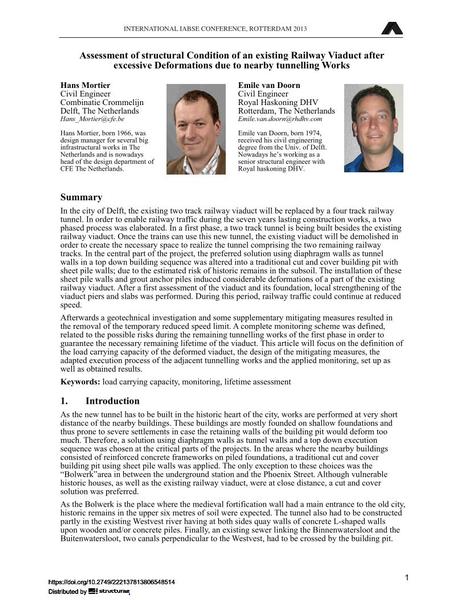Assessment of structural Condition of an existing Railway Viaduct after excessive Deformations due to nearby tunnelling Works

|
|
|||||||||||
Bibliographic Details
| Author(s): |
Hans Mortier
Emile van Doorn |
||||
|---|---|---|---|---|---|
| Medium: | conference paper | ||||
| Language(s): | English | ||||
| Conference: | IABSE Conference: Assessment, Upgrading and Refurbishment of Infrastructures, Rotterdam, The Netherlands, 6-8 May 2013 | ||||
| Published in: | IABSE Conference, Rotterdam, May 2013 | ||||
|
|||||
| Page(s): | 602-603 | ||||
| Total no. of pages: | 8 | ||||
| Year: | 2013 | ||||
| DOI: | 10.2749/222137813806548514 | ||||
| Abstract: |
In the city of Delft, the existing two track railway viaduct will be replaced by a four track railway tunnel. In order to enable railway traffic during the seven years lasting construction works, a two phased process was elaborated. In a first phase, a two track tunnel is being built besides the existing railway viaduct. Once the trains can use this new tunnel, the existing viaduct will be demolished in order to create the necessary space to realize the tunnel comprising the two remaining railway tracks. In the central part of the project, the preferred solution using diaphragm walls as tunnel walls in a top down building sequence was altered into a traditional cut and cover building pit with sheet pile walls; due to the estimated risk of historic remains in the subsoil. The installation of these sheet pile walls and grout anchor piles induced considerable deformations of a part of the existing railway viaduct. After a first assessment of the viaduct and its foundation, local strengthening of the viaduct piers and slabs was performed. During this period, railway traffic could continue at reduced speed. Afterwards a geotechnical investigation and some supplementary mitigating measures resulted in the removal of the temporary reduced speed limit. A complete monitoring scheme was defined, related to the possible risks during the remaining tunnelling works of the first phase in order to guarantee the necessary remaining lifetime of the viaduct. This article will focus on the definition of the load carrying capacity of the deformed viaduct, the design of the mitigating measures, the adapted execution process of the adjacent tunnelling works and the applied monitoring, set up as well as obtained results. |
||||
| Keywords: |
lifetime assessment load carrying capacity monitoring
|
||||

